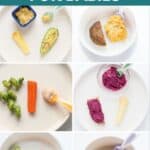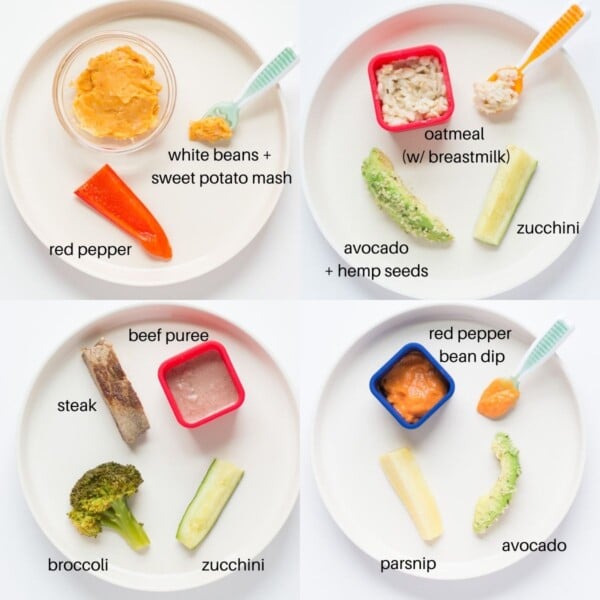This post may contain affiliate links. Please see our disclosure policy for more details.
Chickpeas are wonderful first foods for babies. Here’s how to cook and serve to your baby along with healthy recipes to help make introducing chickpeas fun and doable.
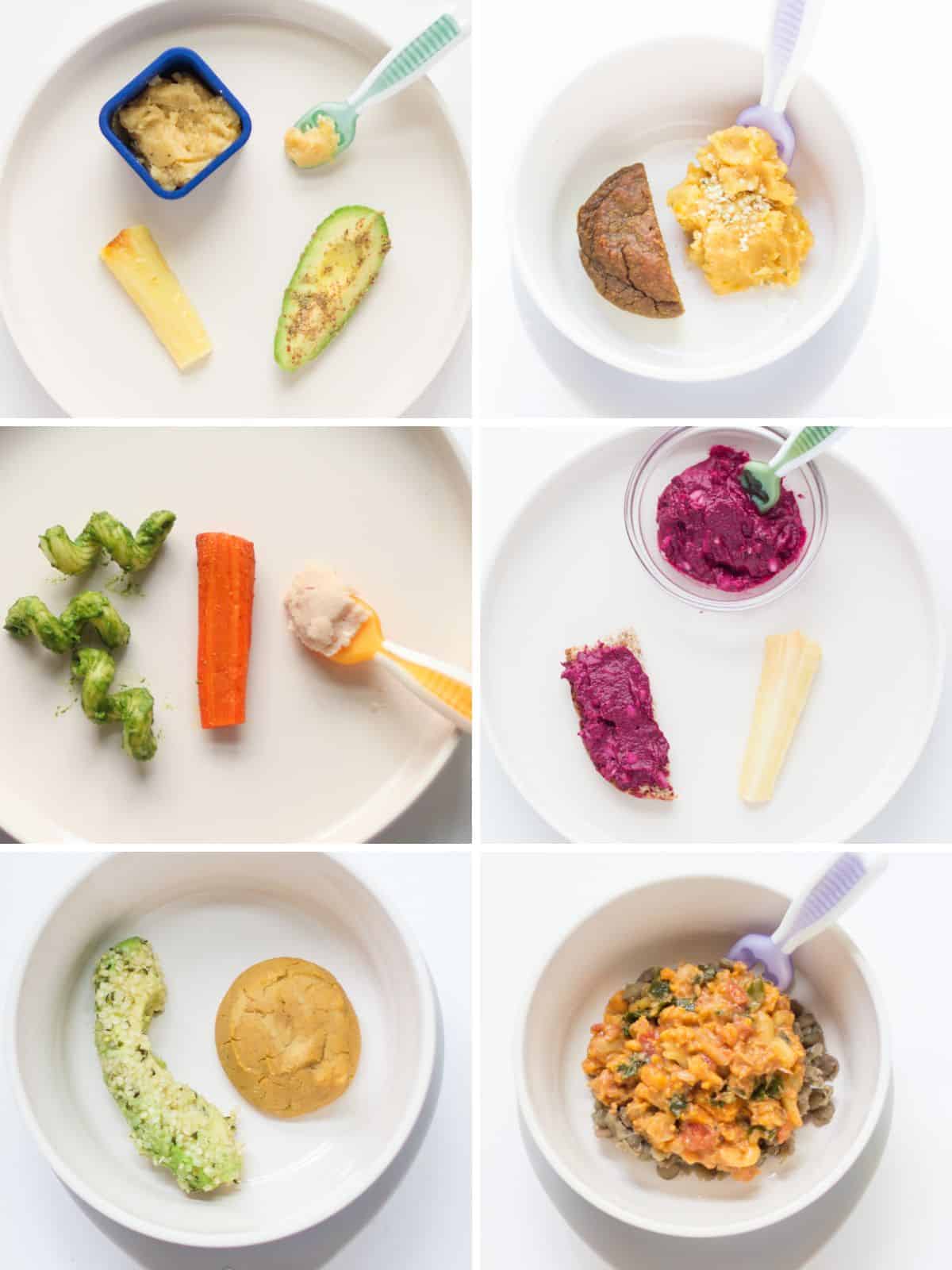
When can babies eat chickpeas?
If cooked to soft, chickpeas can be offered to babies as soon as they’re ready to start solids, usually around 6 months. It’s important to remember that your baby is unique and that rather than going by the calendar, you need to make sure your baby is DEVELOPMENTALLY ready to start solids.
If you’re unsure, be sure to grab my FREE handout!
Table of Contents
Health Benefits
Chickpeas, also known as garbanzo beans, are packed with nutrition! Some of the health benefits include:
- Provides protein, which is essential for their growth and development
- A great source of iron for babies. Be sure to pair with a vitamin C rich food to help enhance its absorption
- Promotes digestive health – they are high in fiber which helps regulate the digestive system
- Supports brain development – contain choline (just like eggs), which research shows is essential for brain development and cognitive function in babies
Are chickpeas safe for babies?
Due to its small and round shape, chickpeas are a choking hazard. To reduce the risk, smash/flatten them, removing any skin that comes off. And follow the age-based serving suggestions shared below.
If you’re cooking the beans rather than using canned, make sure they are soft and easily smushed between your thumb and forefinger.
It’s also very important that you ALWAYS serve food at the table where your baby is sitting upright at a 90 degree angle. Even foods that aren’t considered to choking hazards can be dangerous if given while baby is lying down, crawling, walking, etc.
Cooking Methods
First be sure to sort through to remove any debris or shriveled beans. And while it’s an extra step, I highly recommend soaking next. It will not only decrease cooking time but will also help the chickpeas cook more evenly and make them easier to digest.
The chickpeas will expand upon soaking so be sure to take this into account when choosing the size of the bowl.
In my ultimate guide to beans for babies, I share two different methods for soaking beans.
On the Stove
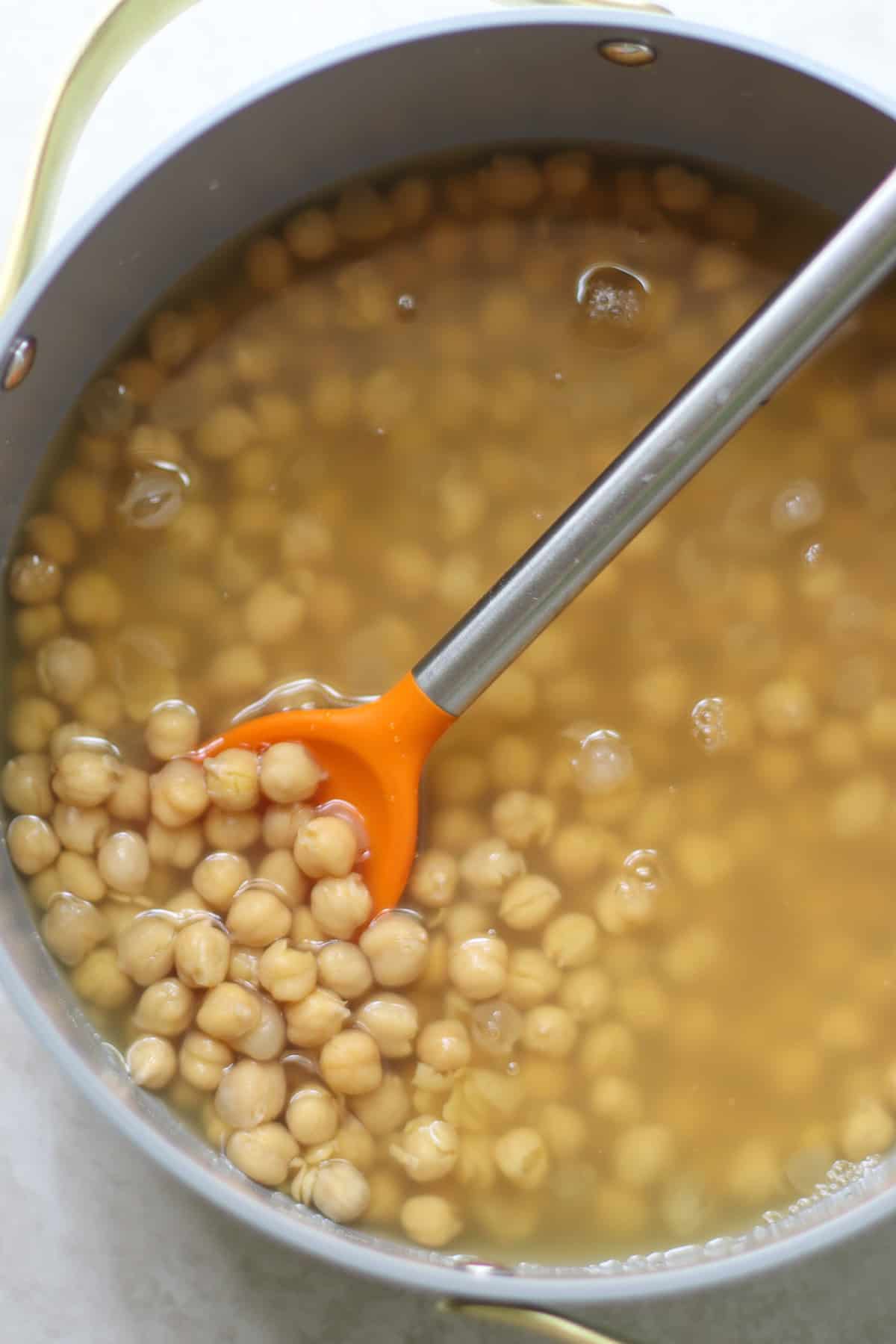
- Add chickpeas to a pot and cover with at least 2 inches of water.
- Bring to a boil. Then reduce heat to low and simmer, with lid slightly open, until tender. It will take about 45-60 minutes
Low and steady for best results! Add more water as needed so that the beans stay submerged.
Slow Cooker
Add chickpeas and 7 cups of water to a slow cooker. Cook on high for 3-4 hours or on low for 6-8 hours.
Instant Pot
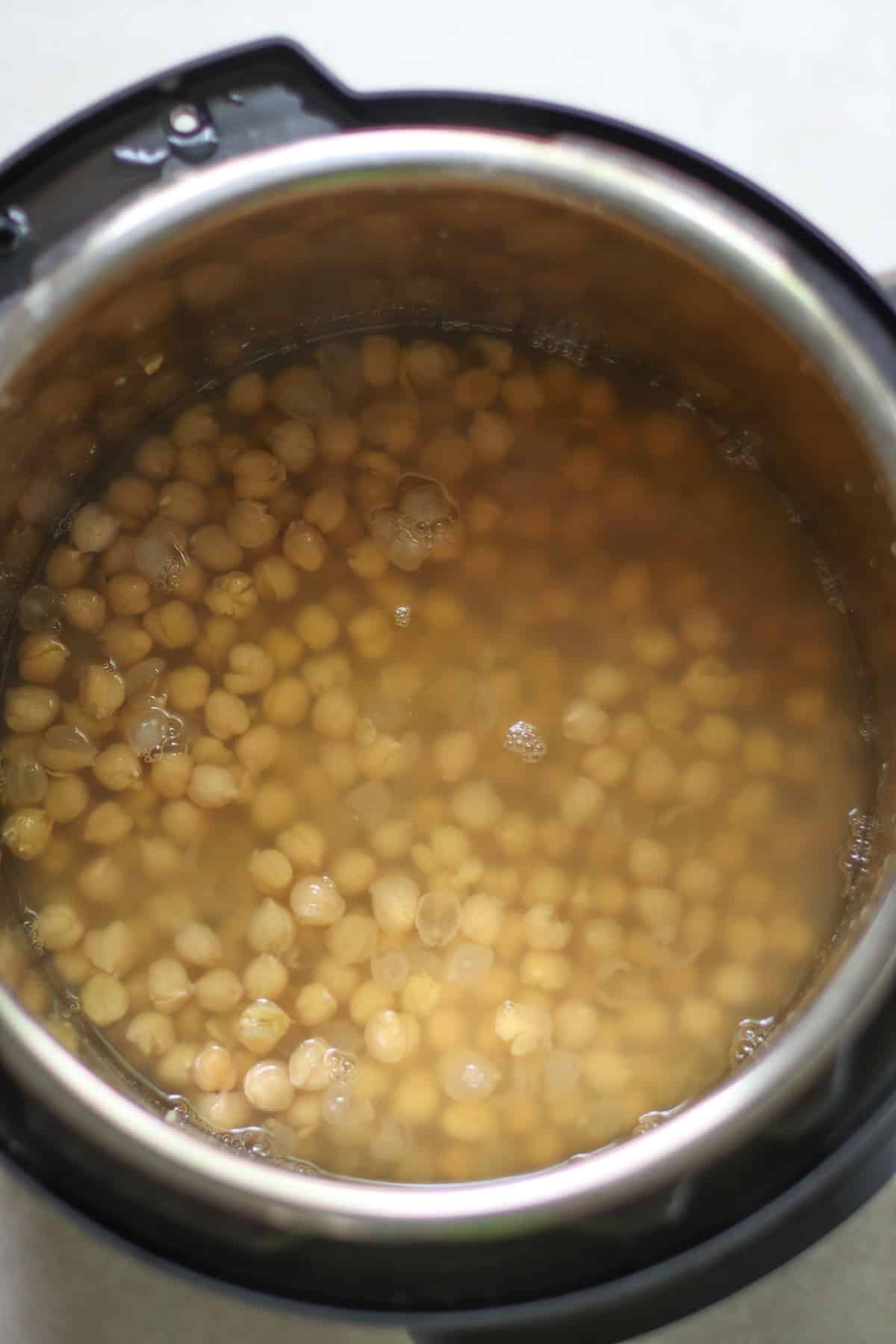
Add beans and 6 cups of water to pressure cooker. Stir, close the lid, and cook on high pressure for 15 minutes.
Allow pressure to release naturally for 10 minutes. This will help beans retain their shape and avoids the liquid from foaming up into the steam valve.
Canned Chickpeas
While dried beans are less expensive, canned ones are so convenient and great time-savers since they are fully cooked. They are just as nutritious as the dried chickpeas.
I used to cook them all the time, but now that I’m a mom of two, I more often than not turn to canned chickpeas to save much needed time and energy.
Be sure to look for ones that are labeled “no salt added” or “low sodium” and that come with non-BPA lining. Rinsing them in running water can lower the sodium content even more.
Note that one can of chickpeas contain 1 1/2 cups of cooked chickpeas. A pound of dried beans (about 2 cups) will yield 6 cups of cooked chickpeas, which is equivalent to about 4 cans.
How to serve chickpeas to baby
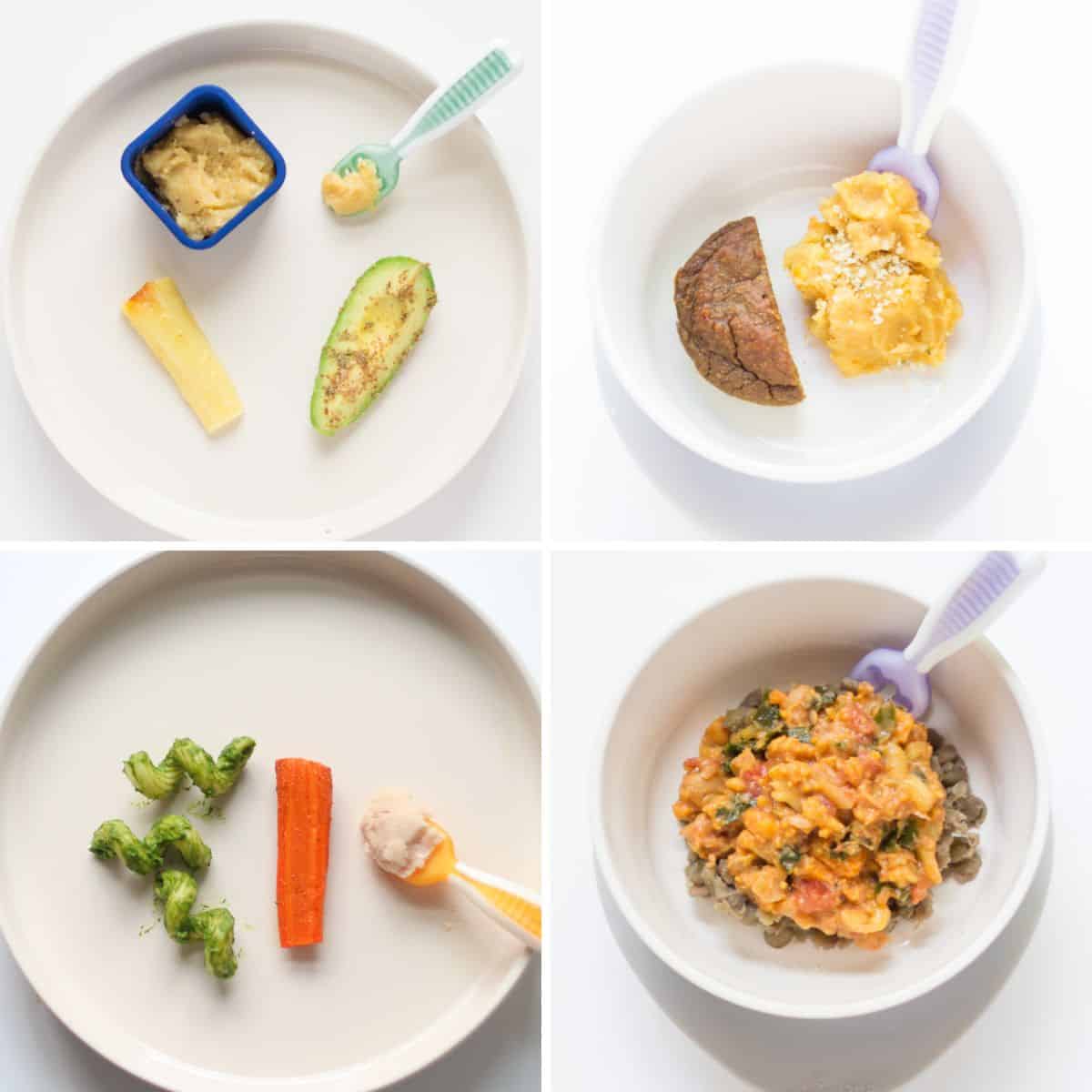
6+ Months
Puree/blend or mash the beans. The consistency is pretty thick and dry so add some breastmilk/formula to thin it out.
And here are some fun and EASY ways to boost nutrition and introduce your baby to a ton of flavors and texture in one bite. Add chickpeas to:
- Yogurt
- Avocado
- Mashed sweet potatoes
- Mashed butternut squash
- Oatmeal – follow the recipe and then add the chickpeas once cooked
- Lentils
- Quinoa
- Hummus/Dip (recipes linked below)
- Toast – spread a thin layer of hummus on top
Pictured above are the exact meals I served to my baby during her first month of starting solids. I actually filmed EVERYTHING I made for her as well as my toddler, husband, and me from Day 1 to Day 84 (so 3 months) in real time and turned it into an easy to access and follow program!

Do you want to minimize picky eating and set a solid foundation for a lifetime of healthy eating habits?
Check out this 3 month mastering self-feeding program! It’s the closest thing to me being in your kitchen
9+ Months
Once your baby has developed their pincer grasp, you can offer flattened chickpeas as a finger food.
Continue combining with other foods. It’s important that they get exposed to mixed foods early before your baby becomes more selective. If they’ve never had foods touching and mixed together, it will be much harder to get them to eat these later on.
If you haven’t already, this is a good time to introduce baby utensils (linked our favorites).
12 Months
Continue offering flattened chickpeas until you observe that your toddler is ready for whole pieces.
Chickpea Recipes for Babies and Toddlers
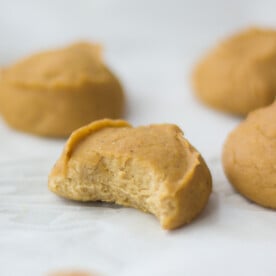
Peanut Butter Chickpea Cookies

Healthy Sweet Potato Cookies

Healthy Beet Muffins for Babies

Beet Hummus for Babies

Broccoli Hummus Dip
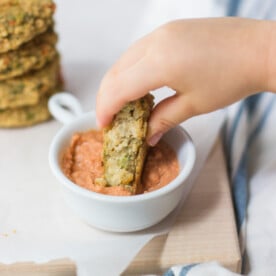
Chickpea Patties (gluten free)
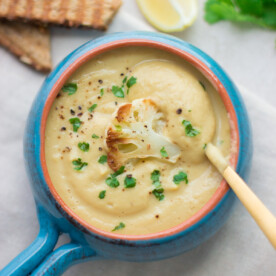
Vegan Chickpea Cauliflower Soup

Beetroot Dip with chickpeas

Chickpea Cookie Dough

Indian Spiced Roasted Cauliflower and Chickpeas
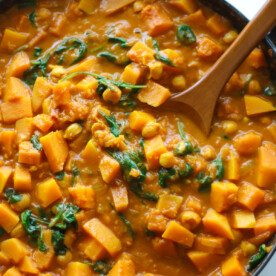
Butternut Squash Curry with chickpeas
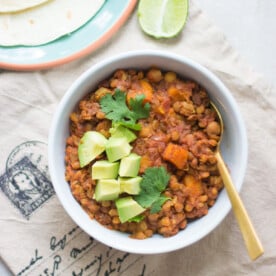
Slow Cooker Lentil Chili with Chickpeas
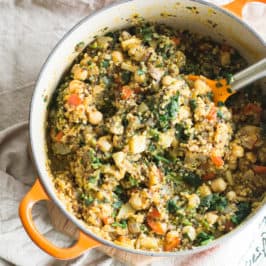
One Pot Parmesan Pumpkin Quinoa
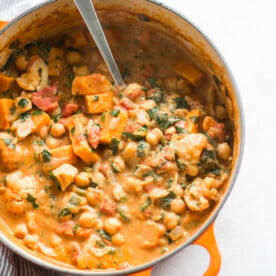
Vegan African Peanut Stew
Frequently Asked Questions
Yes! They are so convenient and just as nutritious as the dried chickpeas. Just be sure to look for ones that are labeled “no salt added” or “low sodium” and that come with non-BPA lining. Rinsing them in running water can lower the sodium content even more.
Foods that are rich in fiber tend to cause gas. This list includes beans, cruciferous vegetables, oatmeal, prunes, peaches, and pears.
There’s no need to avoid these foods completely as they offer so many beneficial nutrients that are essential for proper growth and development. Additionally, early introduction to a wide variety of flavors and textures is key in minimizing picky eating down the road.
If cooking dried chickpeas, soaking can help reduce the risk of gas and make them easier to digest.
Start by offering a small amount (1-2 tablespoons) and gradually serve more.
If your baby becomes gassy but doesn’t seem to be in discomfort, there’s no reason to worry. Also offer different varieties of beans, not just chickpeas.
Chickpeas are a good source of dietary fiber and actually promote healthy bowel movement in babies and prevent constipation.
However, as with any new food, it is possible for some babies to experience constipation or other digestive issues. So introduce chickpeas gradually and in small amounts to give your baby’s digestive system time to adjust.
Chickpeas are not one of the top allergens In the United States. However, chickpea allergy has been found to be common in India and Mediterranean where chickpea consumption is much higher than other places in the world.
Also note that individuals who are allergic to other legumes, particularly lentils, are at a higher risk of chickpea allergy.
As with any new food, start with just a small amount and gradually increase over time.
If you want to learn how to prepare other specific food(s), check out my How To Series!

How to Cook Chickpeas for Babies
Equipment
Ingredients
- 1 pound (2 cups) dried chickpeas
- Water or broth
Instructions
Prepare the chickpeas
- Sort through the beans to remove any debris or shriveled beans. Soak overnight or quick soak. Drain and rinse well.
On the stove
- Add chickpeas to a pot and cover with at least 2 inches of water. Bring to a boil. Then reduce heat to low and simmer, with lid slightly open, until tender. It will take about 45-60 minutes. Add more water as needed so that the beans stay submerged.
Slow Cooker
- Add chickpeas and 7 cups of water to a slow cooker. Cook on high for 3-4 hours or on low for 6-8 hours.
Instant Pot
- Add chickpeas and 6 cups of water to pressure cooker. Stir, close the lid, and cook on high pressure for 15 minutes.
- Allow pressure to release naturally for 10 minutes. This will help beans retain their shape and avoids the liquid from foaming up into the steam valve.
Notes
- To store:
- Once cooked, drain excess liquid and transfer to an airtight container. Store for up to 4 days.
- In the freezer – I recommend freezing in 1 1/2 cup portions (which is how much is in 1 can of chickpeas. Freeze for up to 3 months.

